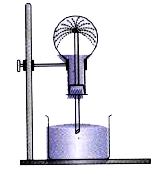In the Fountain experiment with ammonia, the colour of the fountain is
Red
Blue
Pink
Dark green
The correct Answer is:B
Step-by-Step Solution:
1. Understanding the Fountain Experiment:
- The fountain experiment involves a setup with two round-bottom flasks connected by a tube. One flask is filled with water and phenolphthalein, while the other flask contains ammonia gas.
2. Setup Description:
- The flask containing water and phenolphthalein is positioned below the flask containing ammonia gas. A clamp is used to control the flow of water.
3. Opening the Clamp:
- When the clamp is opened, water is drawn up from the lower flask into the upper flask. This movement is due to the pressure difference created by the ammonia gas.
4. Role of Phenolphthalein:
- Phenolphthalein is a pH indicator that changes color in response to the acidity or basicity of a solution. In a basic environment, it turns pink.
5. Effect of Ammonia:
- Ammonia (NH3) is a basic gas. When it comes into contact with the phenolphthalein in the water, it raises the pH of the solution, making it basic.
6. Observation of Color Change:
- As the water containing phenolphthalein rises and mixes with ammonia, the solution turns pink due to the basic nature of ammonia.
7. Conclusion:
- Therefore, in the fountain experiment with ammonia, the color of the fountain is pink.
Final Answer:
The color of the fountain in the experiment with ammonia is pink.
---
- The fountain experiment involves a setup with two round-bottom flasks connected by a tube. One flask is filled with water and phenolphthalein, while the other flask contains ammonia gas.
- The flask containing water and phenolphthalein is positioned below the flask containing ammonia gas. A clamp is used to control the flow of water.
- When the clamp is opened, water is drawn up from the lower flask into the upper flask. This movement is due to the pressure difference created by the ammonia gas.
- Phenolphthalein is a pH indicator that changes color in response to the acidity or basicity of a solution. In a basic environment, it turns pink.
- Ammonia (NH3) is a basic gas. When it comes into contact with the phenolphthalein in the water, it raises the pH of the solution, making it basic.
- As the water containing phenolphthalein rises and mixes with ammonia, the solution turns pink due to the basic nature of ammonia.
- Therefore, in the fountain experiment with ammonia, the color of the fountain is pink.
The color of the fountain in the experiment with ammonia is pink.
Topper's Solved these Questions
- MOLE CONCEPT & STOICHIOMETRY (PART-A GAY LUSSAC'S LAW - AVOGADRO'S LAW-MOLE CONCEPT)Book:ICSEChapter: MOLE CONCEPT & STOICHIOMETRY (PART-A GAY LUSSAC'S LAW - AVOGADRO'S LAW-MOLE CONCEPT)Exercise:Problems based on Mole Concept & Avogadro.s Number
Explore 13 Videos
- MOLE CONCEPT & STOICHIOMETRY (PART-A GAY LUSSAC'S LAW - AVOGADRO'S LAW-MOLE CONCEPT)Book:ICSEChapter: MOLE CONCEPT & STOICHIOMETRY (PART-A GAY LUSSAC'S LAW - AVOGADRO'S LAW-MOLE CONCEPT)Exercise:Problems based on Mole Concept & Avogadro.s Law
Explore 2 Videos
- ACIDS, BASES AND SALTSBook:ICSEChapter:ACIDS, BASES AND SALTSExercise:Unit Test Paper 3A- Acids, Bases & Salts
Explore 14 Videos
Similar Questions
Give suitable reason(s) for each of the following:
In the Fountain experiments with ammonia and hydrogen chloride, water is added into the Flask with a dropper but not in case of HCl.
View SolutionGive reasons for the following
In the fountain experiment to demonstrate the high solubility of HCl gas in water , dry HCl gas is filled in the round bottom flask
View SolutionAmmonia is.
View SolutionComplete the following using the correct word given in the brackets.
Fountain experiment shows that ammonia is _____soluble in water. (not/highly)
View SolutionThe diagram shows a simple arrangement of the fountain experiment:

What is the common property demonstrated by this experiment?
View SolutionThe diagram shows a simple arrangement of the fountain experiment:
What is the common property demonstrated by this experiment?

View SolutionIn the Young’s double slit experiment, for which colour the fringe width is least
View SolutionName two gases which can be used in the study of the fountain experiment. State the common property demonstrated by the fountain experiment.
View SolutionA water fountain on the ground sprinkles water all around it . If the speed of water coming out of the fountain is v , the total area around the fountain that gets wet is :
View SolutionThe diagram shows a simple arrangement of the fountain experiment:
Name the two gases you have studied which can be used in this experiment.

View Solution

